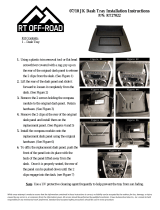
4
INSTALACIÓN DE LA INTERFAZ AXXESS
• Genera corriente de accesorios (12 voltios 10 amperes)
• Conserva R.A.P. (corriente de accesorio retenida)
• Ofrece salidas de NAV (freno de mano, reversa, sensor de velocidad)
•
Permite la visualización de la climatización (HVAC) y los medidores en la pantalla de Pioneer
• Permite el ajuste de las funciones de climatización (HVAC) mediante la pantalla Pioneer
• Conserva los controles de audio en el volante
• Permite forzar automáticamente el arranque / alto (en caso de estar equipado)
• Funciona tanto en los vehículos de zona única como en los vehículos de doble zona
• Conserva los tonos de seguridad (la bocina se vende por separado)
• Diseñado para vehículos amplificados y no amplificados
• Actualizable por micro USB B
• Permite la retención y el ajuste de la configuración de personalización de OE
• Instalación lista para usarse
• Diseñado para DMH-W4600NEX/WC4660NEX de Pioneer
• Pintura negro mate resistente a las rayaduras para igualar el acabado original
• Incluye el adaptador de antena para radio y el adaptador de antena para GPS
• Incluye el repuesto de cámara original directa impermeable con clasificación nominal -IP68
• Incluye un cable de repuesto USB/AUX/HDMI® de 3’ con panel
CARACTERÍSTICAS
• Herramienta de prensado y conectores o pistola soldadora, soplete y tubo termoretráctil
• Cinta
• Cortador de cables
• Sujetadores
HERRAMIENTAS NECESARIAS
• LD-CH5-PIO • LD-CHRYHAZ2T • LD-2PIN-CAN
• Interfaz de radio • Cámara de Jeep (JP-JLKT)
• Arnés PR04AVIC-PIO o PR04-PIORCA • Bocina externa
• AXUSB-RAM1
Instalación de AXUSB-RAM1 ......................................................................................................... 5
Retiro de la cámara .................................................................................................................. 6-8
Ensamble de la cámara ...............................................................................................................9
Cableado .......................................................................................................................................10
Instalación de cámara y repuesto de USB ..................................................................................11
Instalación de la interfaz .............................................................................................................12
Ensamble del tablero ..................................................................................................................13
Operación de radio ................................................................................................................. 14-15
Especificaciones ...........................................................................................................................16
COMPONENTES
ÍNDICE

























